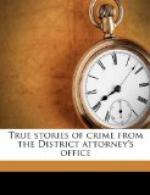But now came the second error, which resulted in the exposure of the conspiracy and conviction for murder. Jones, in filling out the twenty-five thousand dollar check on Swenson, had in his nervousness omitted the “l” from Patrick’s Christian name, so that the check read “Abert T. Patrick,” and Patrick in his excitement had failed to notice the omission or attempt to obviate it by extra indorsement. This twenty-five thousand dollar Swenson check was intrusted to David L. Short for presentation to Swenson & Sons for certification. When he presented it, Wallace, the clerk, recognized Jones’s handwriting in the body of it, and thought the signature looked unnatural. He took it to a rear office, where he showed it to Wetherbee, who was the person whom Jones had approached nine months before with a request that he join the conspiracy to manufacture a bogus will. Wetherbee compared the signature on the check with genuine signatures in the bank, and returned it to Short without any intimation that he regarded it as irregular, but assigning as the reason the defect in the indorsement. Short thereupon returned the check to Patrick, who supplied the necessary supplementary indorsement and telephoned to Jones what had occurred, instructing him to say that the check was all right in case the Swensons should inquire.
Half an hour later Short returned to Swenson’s, where the check was examined by one of the firm. Rice’s apartments were then called up, and Jones said that the checks were all right. But this did not satisfy Mr. Swenson, so he instructed Wallace to call up the apartment again and insist on talking to Mr. Rice. Jones delayed replying to Wallace and in the afternoon called up Patrick on the telephone, inquiring what he should say. Patrick replied that he would have to say that Rice was dead. And in accordance with this Jones informed Swenson that Rice had died at eight o’clock the previous evening. It was thus clear to Swenson that although the maker of the check was dead, Patrick, a lawyer, cognizant of that fact, was seeking to secure payment upon it. For Jones had told Swenson that he had reported Rice’s death to the doctor and to Rice’s lawyer, Patrick.
Patrick, accompanied by Potts, went immediately to the bank, where Swenson informed him that the check could be paid only to the administrator. Patrick replied that there would be no administrator; that Rice had left no property in this State, and informed Swenson that he had an assignment by Rice to himself of all Rice’s securities with Swenson. He also invited Swenson to the funeral.
Later in the day Patrick attempted to obtain possession of Rice’s securities in the Safety Deposit Company and in the Fifth Avenue Trust Company, by presenting forged instruments of transfer and the orders heretofore referred to; but after some delay the trust companies declined him access. The conspiracy had begun to go to pieces. The two mistakes and the failure to secure funds placed Patrick in a dangerous position.




